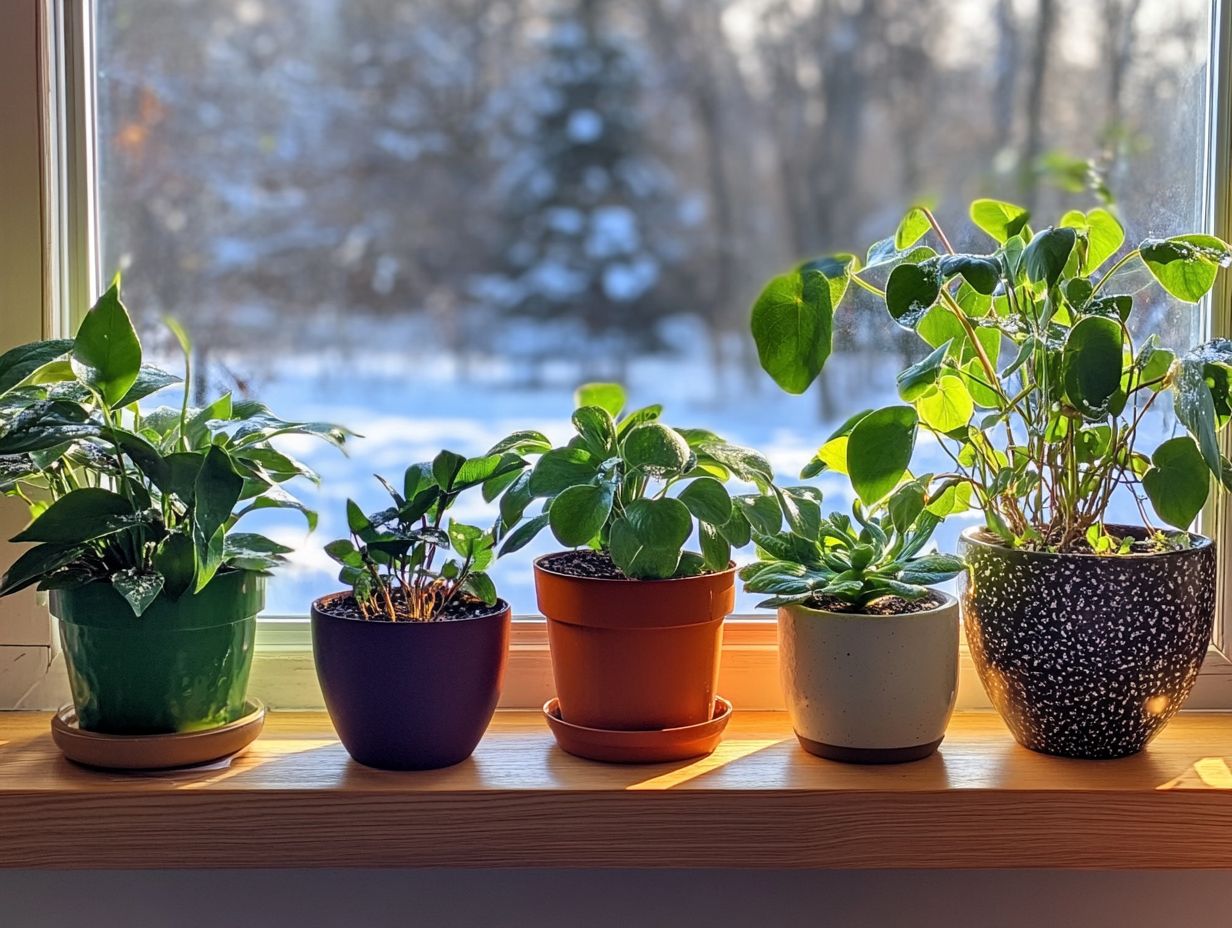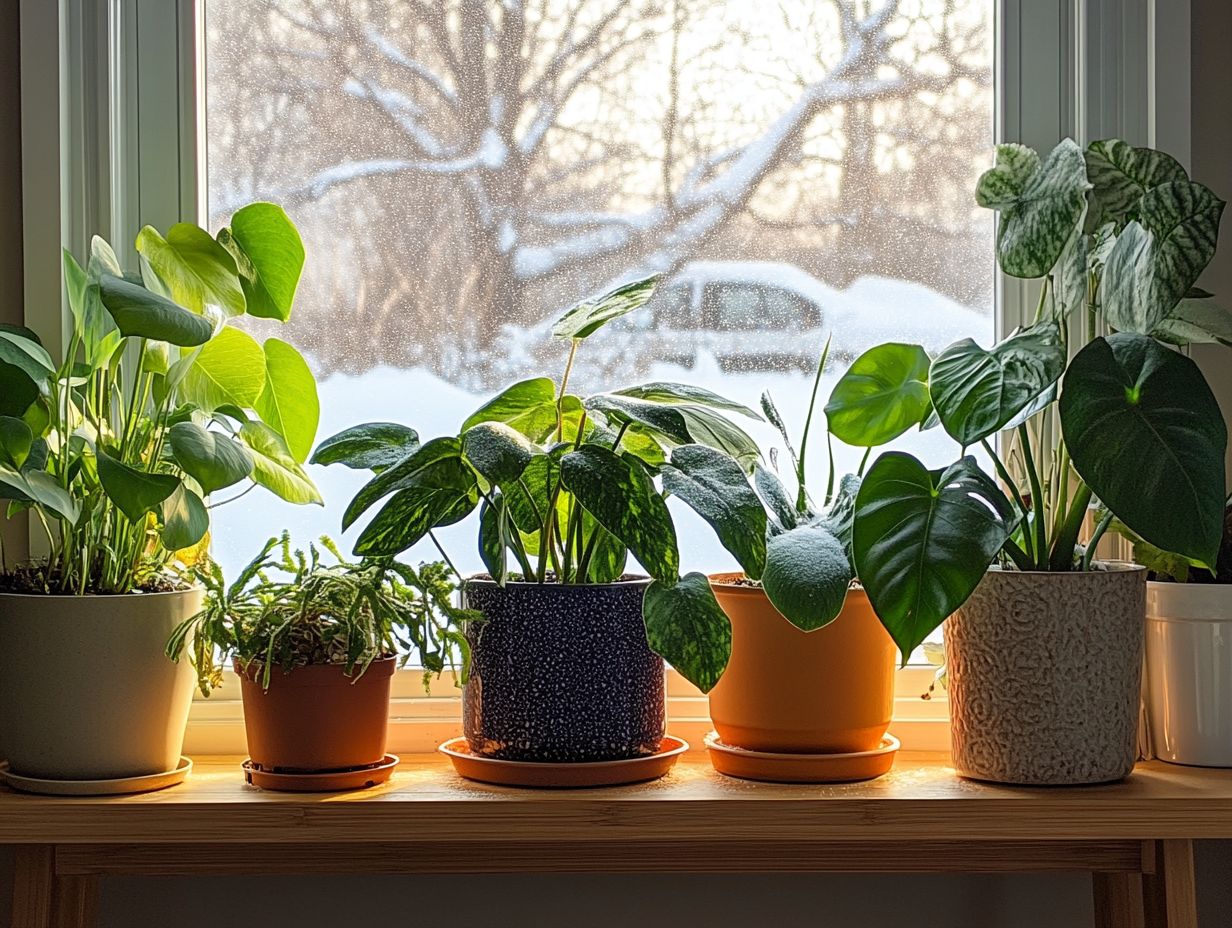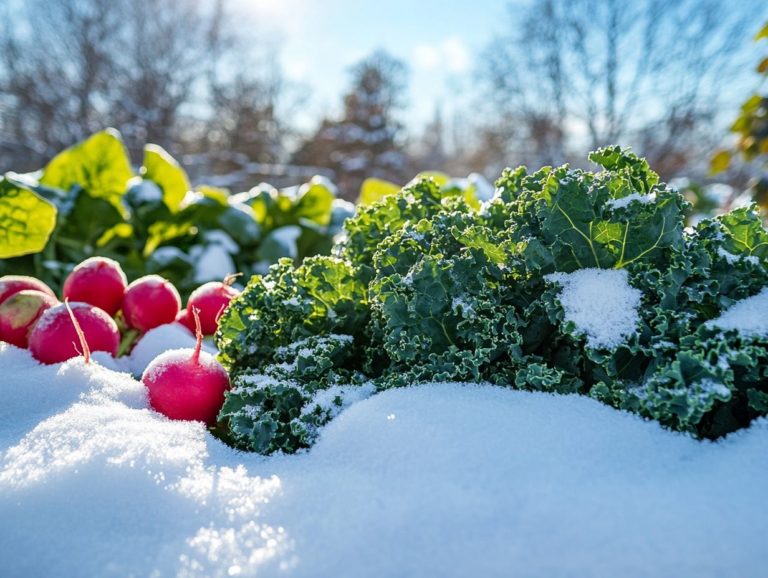5 Best Indoor Plants for Winter Care
Winter may cast a dreary spell, but introducing a hint of greenery into your home can transform your space and elevate your mood.
This article explores five of the best indoor plants that thrive during the colder months, providing beauty and a wealth of benefits for your well-being.
Indoor plants help clean the air and thrive in low light, along with essential care tips to keep them flourishing.
Discover how to avoid common pitfalls and bring life into your winter decor now! Prepare to brighten your winter days with a touch of nature!
Contents
- Key Takeaways:
- 1. Peace Lily
- 2. Snake Plant
- 3. Chinese Evergreen
- 4. ZZ Plant
- 5. Pothos
- What Are the Benefits of Having Indoor Plants in Winter?
- How Do Indoor Plants Help Improve Air Quality?
- What Are the Best Indoor Plants for Low Light Conditions?
- How Can One Care for Indoor Plants During Winter?
- What Are the Common Mistakes to Avoid When Caring for Indoor Plants in Winter?
- How Can One Incorporate Indoor Plants into Their Home Decor for Winter?
- Frequently Asked Questions
- What are the best indoor plants for winter care?
- Why are these plants great for winter care?
- How should I care for my peace lily in winter?
- What is the ideal temperature for snake plants in winter?
- Can I place my pothos near a drafty window in winter?
- How often should I fertilize my spider plant in winter?
Key Takeaways:

- Peace Lily: A low-maintenance, air-purifying plant that thrives in low light.
- Snake Plant: A hardy plant that improves air quality and adds a touch of green.
- Chinese Evergreen: A versatile plant that tolerates low light and cold temperatures, perfect for winter.
1. Peace Lily
The Peace Lily (Spathiphyllum) shines as one of the top winter houseplants. It flourishes in low light while cleaning your indoor air, making it a great companion for the colder months. For those interested in keeping their plants healthy during winter, check out these best practices for overwintering plants.
This remarkable plant boasts glossy dark green leaves and graceful white blooms. It plays a vital role in improving indoor air quality by removing harmful toxins like formaldehyde and benzene.
The Peace Lily is easy to care for. It needs moderate watering and thrives in indirect sunlight. Enjoy its stunning white blooms, adding elegance to any room.
If you’re looking to add a resilient and beneficial element to your home, this houseplant is an exceptional choice.
2. Snake Plant
The Snake Plant (Sansevieria) is known for its resilience and low maintenance. It’s an ideal indoor plant choice, especially in winter when light levels dip.
These hardy plants thrive in dimly lit spaces and require minimal watering. They are perfect for those who may forget regular plant care. The Snake Plant also features striking architectural leaves that enhance your home decor.
With its air-purifying abilities, this plant quietly improves indoor air quality by absorbing toxins and releasing oxygen, making it beneficial during stuffy winter days.
3. Chinese Evergreen
The Chinese Evergreen (Aglaonema) is a fantastic winter houseplant choice due to its vibrant foliage and adaptability to various humidity levels.
This plant comes in many varieties, each featuring unique color patterns, from lush greens to bold reds and silvers. There’s an Aglaonema to match everyone’s aesthetic!
For instance, the ‘Silver Bay’ variety displays striking silver markings, while the ‘Red Valentine’ captivates with its crimson edges.
Aglaonema is resilient, thriving in low light conditions. For winter health, water moderately, avoiding over-saturation, and maintain consistent humidity to prevent leaf browning. Regularly wipe the leaves to help them soak up available light, promoting luscious growth.
Choose one of these vibrant plants today to brighten your winter and breathe life into your home!
4. ZZ Plant

The ZZ Plant, or Zamioculcas zamiifolia, is a great choice for your indoor garden during winter.
It thrives in low light, retains moisture well, and requires minimal care ideal for busy lifestyles.
Its glossy leaves capture light beautifully. This plant enhances your space’s appeal while acting as a natural air purifier by removing toxins.
Its drought tolerance allows it to go long periods without water, making it perfect for moments when you forget to water it in winter.
By adding this resilient plant to your home, you boost both aesthetics and air quality, creating a refreshing atmosphere as winter settles in.
5. Pothos
Pothos, or Epipremnum aureum, is one of the most versatile indoor plants.
It flourishes in low light and adds vibrant foliage to your decor, making it a fantastic companion in winter.
This plant adapts to various environments, from bright indirect sunlight to cozy dim corners.
You can choose from several types, including Golden Pothos, Marble Queen, and Pearls and Jade, each showcasing unique patterns.
To help your Pothos thrive in winter, reduce watering and allow the soil to dry slightly between intervals.
These plants improve indoor air quality by filtering toxins, helping you maintain a healthy space even as the weather gets chilly.
What Are the Benefits of Having Indoor Plants in Winter?
Indoor plants offer numerous benefits during winter, including improved air quality and stress reduction, and following 5 tips for successful indoor winter gardening can enhance your gardening experience.
They also help maintain optimal humidity levels in your home, making them essential for your indoor environment.
As the cold months approach, you’ll likely spend more time indoors, which can cause stale air and seasonal gloom.
Indoor plants like the Peace Lily and Snake Plant beautify your space and purify the air by filtering out toxins.
With every breath, you inhale cleaner air, especially important when windows are shut tight in winter.
These plants can also help reduce stress. Research shows that interactions with nature lower cortisol levels.
Your indoor space can become a sanctuary for peace of mind, thanks to plants that regulate humidity.
Dry indoor air can lead to discomfort and respiratory issues, but plants help keep humidity levels balanced.
This promotes overall well-being and enhances your comfort.
How Do Indoor Plants Help Improve Air Quality?
Indoor plants significantly improve air quality during winter.
They filter out volatile organic compounds (VOCs) and release oxygen, with species like the Peace Lily and Snake Plant excelling in purification.
These plants absorb toxins through their leaves and roots, neutralizing harmful substances like formaldehyde and benzene.
A study from NASA revealed that certain houseplants can eliminate up to 87% of these toxins within just 24 hours, showing their power in maintaining a healthy indoor environment.
As winter approaches and windows stay closed, having air-purifying plants becomes even more crucial.
They not only enhance your space’s aesthetic but also significantly contribute to stress reduction and overall well-being providing a refreshing boost of oxygen in your daily life.
What Are the Best Indoor Plants for Low Light Conditions?

For those navigating spaces with limited natural light, certain indoor plants truly shine in low light conditions. Consider the Peace Lily, Snake Plant, Pothos, and Aglaonema; they are the perfect companions for your winter indoor oasis, especially when combined with best practices for winter herb care.
These resilient plants not only survive but actually thrive in dimly lit environments, infusing your home with a touch of greenery even when the days are short and dreary. The Peace Lily, with its elegant white blooms, offers a refreshing contrast to those darker corners. The tall, sturdy leaves of the Snake Plant add a striking architectural element to your space.
Pothos, famous for its trailing vines, instantly brings life to your space! Meanwhile, the Aglaonema showcases vibrant foliage that can brighten the dullest of areas.
Each of these varieties demands minimal care, often requiring just an occasional drink of water and some indirect light, making them ideal for your busy lifestyle.
How Can One Care for Indoor Plants During Winter?
Caring for your indoor plants during winter requires attention to key factors like temperature fluctuations, moisture in the air, and moisture retention. For those looking to enhance their indoor space, consider incorporating some of the 5 must-have plants for winter gardens to ensure that your winter houseplants not only survive but thrive throughout the colder months.
As temperatures drop, it s essential to maintain a consistent watering schedule. Allow the top inch of soil to dry out between waterings for many plants, striking the right balance to keep them happy.
For tropical species, additional humidity can make all the difference. Consider using a humidifier or placing them on trays filled with water and pebbles to create a cozy atmosphere they ll love.
Ensure your plants receive adequate light by positioning them near south- or west-facing windows. Adjust your care routines based on the specific needs of each plant. Some species may handle lower light levels better than others, so paying close attention to their individual preferences will help you navigate the unique challenges winter brings.
What Are the Common Mistakes to Avoid When Caring for Indoor Plants in Winter?
When caring for your indoor plants during winter, it’s easy to fall into common traps like overwatering, neglecting light levels, and overlooking humidity adjustments. To avoid these pitfalls, consider following the 5 best practices for winter plant care, as these can seriously affect the health of your treasured houseplants.
These missteps often stem from a misunderstanding of how winter conditions differ from the rest of the year. Many people mistakenly believe their plants need the same amount of water and light, even when temperatures drop and days grow shorter.
It’s crucial to understand that indoor plants, particularly tropical varieties, may thrive in warmth but can be quite sensitive to sudden changes in moisture and light during the colder months. By tailoring your care and researching the best indoor plants for cold climates, you can avoid these pitfalls and ensure optimal growth even amidst winter’s chill.
How Can One Incorporate Indoor Plants into Their Home Decor for Winter?
Incorporating indoor plants into your home decor during winter not only infuses color and interest but also elevates the overall ambiance. For effective care, consider caring for indoor plants during winter by choosing winter houseplants like the Peace Lily and Pothos, which bring vibrant foliage to your living spaces.
These plants seamlessly complement a variety of decor styles, whether you lean towards sleek lines of modern minimalism or the warm, rustic charm of farmhouse aesthetics.
When positioning these lively green companions, think about utilizing shelves, window sills, or even hanging planters to maximize their visual impact.
Pair your plants with colorful pots that reflect your room’s palette to enhance the overall look. In the colder months, strategically placing these greens near light sources not only ensures their health but also invites a cozy atmosphere, making any space feel more inviting, warm, and alive during the chilly season.
Watch the video to learn more about caring for your indoor plants during winter!
Frequently Asked Questions

Start transforming your home today with these stunning indoor plants!
What are the best indoor plants for winter care?
The top five indoor plants for winter are the peace lily, snake plant, pothos, spider plant, and Chinese evergreen.
Why are these plants great for winter care?
These hardy plants can handle low temperatures and limited sunlight. For optimal care during this season, check out this guide on how to care for indoor plants in winter; they are perfect for indoor winter conditions.
How should I care for my peace lily in winter?
Peace lilies love low light. Water them once a week, keeping the soil moist but not soggy.
Mist the leaves occasionally to boost humidity.
What is the ideal temperature for snake plants in winter?
Snake plants do best in temperatures between 55 F and 85 F. They thrive wonderfully in indoor winter settings.
Can I place my pothos near a drafty window in winter?
Avoid placing any plant near a drafty window. Cold air can harm the leaves.
However, pothos can adapt to various light conditions.
How often should I fertilize my spider plant in winter?
It’s best not to fertilize indoor plants during winter. They are in a resting period, so wait until spring to start feeding your spider plant again.






